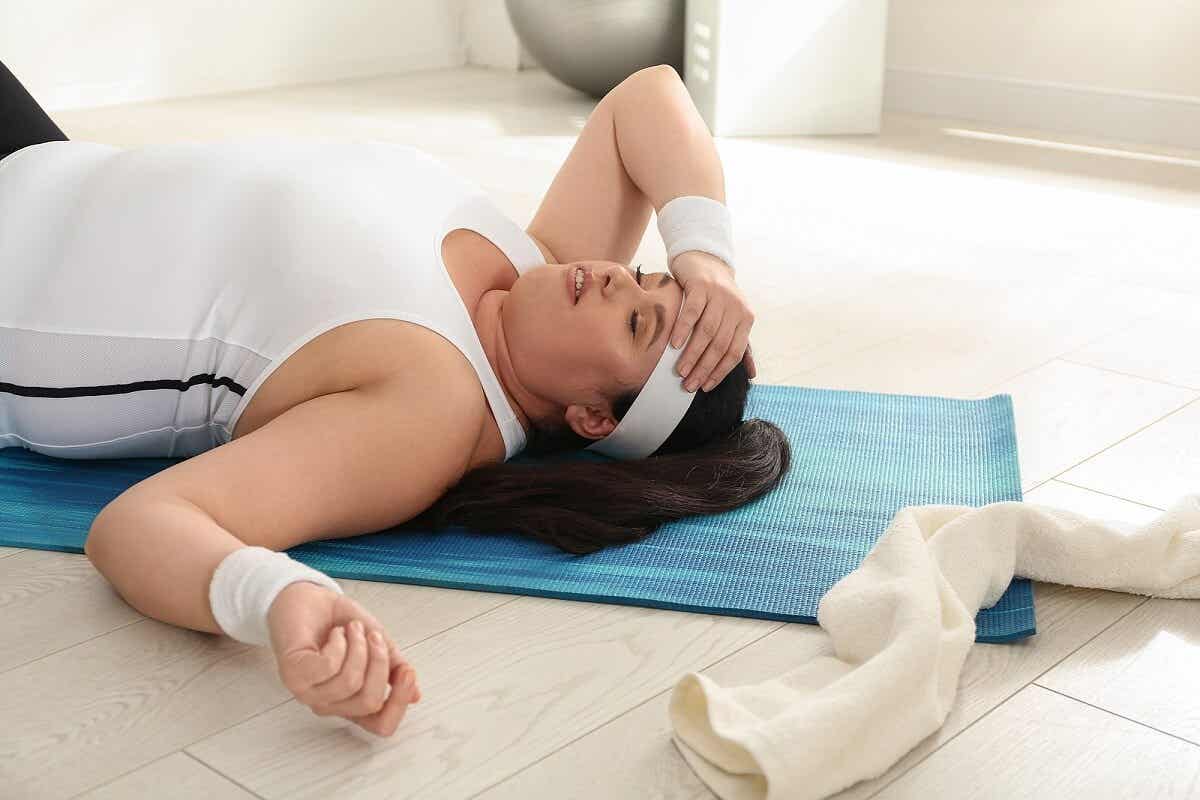Sports and Exercise Tips for People with Hypothyroidism

What exercises are suitable for people with hypothyroidism? Exercise is generally considered to be one of the most important factors for a healthy life. However, some conditions may limit a person’s ability to be physically active, such as thyroid disorders. Read on to find out more about exercise and hypothyroidism.
An underactive thyroid, as this condition is also known, affects the body’s metabolism. It’s also associated with symptoms such as fatigue, arrhythmia, joint pain, depression, and a tendency to gain weight.
In affected individuals, these symptoms may interfere with a regular exercise program. However, if you suffer from hypothyroidism, making physical activity a part of your daily routine is one of the keys to maintaining well-being. So what should you keep in mind? Read on for some tips and recommendations.
How does hypothyroidism affect metabolism?
The thyroid is a small organ (about half the size of a walnut) located in the front of the neck, in the cartilage below the Adam’s apple. Despite its size, it plays an important role in metabolism.
This organ is involved in the production of several hormones, such as thyroxine and triiodothyronine, which affect growth and development. The latter also affects almost all metabolic processes. It even regulates heart rate and body temperature.
In people who suffer from hypothyroidism, the metabolism slows down. This results in various symptoms, such as a tendency to gain weight easily, a feeling of fatigue, joint pain, palpitations, and feeling down.
The low levels of thyroid hormones also tend to reduce cardiac capacity, hence the increased risk of ventricular arrhythmias in people with hypothyroidism.
Moreover, the thyroid contributes to the breakdown of cholesterol and stimulates the production of enzymes needed to eliminate triglycerides. This means that when the level of thyroid hormones drops, bad cholesterol and triglycerides tend to increase.

Read more: How to Overcome Hypothyroidism: 4 Tips
Benefits of exercise for people with hypothyroidism
Regular exercise is very beneficial for people with hypothyroidism. In fact, keeping up a workout routine helps improve the quality of life of people with this condition, as detailed in a trial reported in Archives of Endocrinology and Metabolism.
Metabolism and energy
Often, people with hypothyroidism report constantly feeling a lack of energy. In order to counteract this, doctors often prescribe medications such as levothyroxine.
And while many people may think that exercise worsens this feeling, the opposite is true. Regular workouts help increase energy levels and combat fatigue.
Research shows that low-impact exercise can reduce tiredness and even improve thyroid function in patients with this condition. Indeed, an increase in triiodothyronine and thyroxine has been observed in those who engage in regular physical activity.
Weight, body fat, and muscle mass
According to research, slower metabolism means people with hypothyroidism tend to gain weight and show signs of obesity. And just as body fat percentage increases, muscle mass decreases.
Fortunately, there’s an effective measure to counteract this. And it’s very clear: exercise. First of all, exercise increases calorie burning, which helps with weight loss. Strength training also helps increase muscle volume while reducing the percentage of fat.
In addition, this type of training improves muscle tone and improves the body’s response to exercise. Thus, little by little, the sensation of weakness decreases and cramps become less frequent.
Heart
Studies on the subject have found that hypothyroidism is a clinical condition that has effects on cardiac function. This means that it can affect contractility, vascular resistance, blood pressure, and heart rate.
However, there are exercises that help the heart function and reduce the risk of heart disease. This is excellent news for people with thyroid problems.
Mood and depression
Impaired thyroid function also affects mood. Fortunately, exercise helps activate the “happy hormones”. As a consequence, feelings of gloominess reduce, and well-being increases.
According to a publication in Depression and Anxiety, as little as 45 minutes of moderate aerobic exercise, three times a week, has a significant effect on mood. This positive habit is the natural remedy for sadness, feeling down, and depression.
Other benefits
In addition to the above, exercise contributes to the general well-being of people with hypothyroidism. Other benefits include the following:
- Strength training can contribute to the recovery of bone loss that occurs in people with thyroid disorders.
- Low-impact exercises such as swimming, Tai Chi, or yoga help relieve the joint pain that occurs as an effect of hypothyroidism.
- Finally, rest patterns, which can also be affected, improve with physical activity.
Don’t miss: 10 Signs You May Have Hypothyroidism
Tips and exercises for people with hypothyroidism
People with hypothyroidism should be especially careful before taking on an exercise routine. This is even more true if you’re sedentary or haven’t exercised for some time. With this in mind, you should start slowly, without demanding too much of yourself.
Low impact exercises
The best thing for people with hypothyroidism is to do low-impact cardiovascular exercises such as the following:
- Walking
- Dancing
- Yoga
- Tai chi
- Pilates
- Elliptical cycling
- Swimming
Then, once your body adapts, you can gradually increase the intensity or duration, and move on to more demanding exercises. Of course, remember to always stay within the limits of your ability.
High impact exercises
Among the highest impact physical activities are the following:
- Skipping
- Jogging or running
- Tennis
- Basketball
- Hiking in the mountains
- Road cycling
- Squats and other leg exercises
- Lifting weights
- Calisthenics
Ideally, you should do a minimum of 150 minutes of aerobic or cardiovascular exercise a week. And, in addition, 2 or 3 sessions of combined strength exercises. But if you can’t manage this at first, try to work in sessions of at least 15 minutes.
Strength training is very important for people with hypothyroidism, as it helps to activate the metabolism and burn calories. You need to work all the major muscle groups; at least 2 days a week for each muscle.
If you have a thyroid condition, are overweight, and haven’t trained for some time, you may have to work a little harder. It takes patience and, above all, perseverance to get into shape and achieve a healthy weight.
You’ll see an improvement and achieve better results over time. In order to keep up your enthusiasm to persist, you can choose different exercises each day, and combine routines.
Finally, remember that your heart rate and breathing rate will let you know if you are pushing yourself too hard. If possible, use a heart rate monitor. And, if you feel tired, or something hurts, just stop. It’s not a competition.

Other recommendations
When you exercise on a daily basis, there’s always a risk of breaking your commitment to your routines, for whatever reason. You have to keep your focus, and at the same time your enthusiasm. Here are some recommendations for this.
- Seek help from a professional trainer to design a program tailored to your needs and fitness level
- Exercise with others
- Listen to music while you exercise
- Set goals and targets
- Use an app to help you see your progress
- Never push yourself to the point of exhaustion
- Get outdoors
- Rest at least one day a week
What do people with hypothyroidism need to consider before taking up exercise?
Selecting the best routine depends on physical condition, health status and treatment. If your thyroid hormones are under control and you’re healthy, you’ll be able to do almost any kind of exercise.
Of course, before starting a routine, remember to consult your doctor and take their recommendations about what you should and shouldn’t take into account.
Don’t forget that people with hypothyroidism experience more muscle and joint pain. Some exercises may not affect you in this way, but others may cause impact or tension which aggravates your ailments or injuries.
And remember, if your hormones aren’t under control, then exercise could be dangerous. Be careful, especially if you’re doing a high-intensity activity that increases heart rate.
Keys to exercise and hypothyroidism
Exercise is always beneficial for people with hypothyroidism, and helps counteract symptoms such as weight gain. However, don’t create false expectations. Physical activity won’t make your thyroid produce more hormones.
Keep in mind that this is an autoimmune disease and, therefore, a training plan or a diet can’t cure or reverse the process. This means that it’s essential to keep up with your medical treatment.
All cited sources were thoroughly reviewed by our team to ensure their quality, reliability, currency, and validity. The bibliography of this article was considered reliable and of academic or scientific accuracy.
- British Thyroid Foundation (2024). Coping with exercise. Consultado el día 17 de enero de 2024. https://www.btf-thyroid.org/coping-with-exercise
- D Morres, I., Hatzigeorgiadis, A., Stathi, A., Comoutos, N., Arpin, C., Krommidas, C., Theodorakis, Y. (2018). Aerobic exercise for adult patients with major depressive disorder in mental health services: A systematic review and meta-analysis. Depression and Anxiety; 36(1):39-53. https://pubmed.ncbi.nlm.nih.gov/30334597/
- Duñabeitia, I., González, D., Varela, S., Diz, J., Ayán, C. (2023). Effect of physical exercise in people with hypothyroidism: systematic review and meta-analysis. Scandinavian Journal of Clinical and Laboratory Investigation; 24, 1-10. https://pubmed.ncbi.nlm.nih.gov/37999992/
- Huston, P., McFarlane, B. (2016) Health benefits of tai chi: What is the evidence?. Canadian Family Physician; 62(11), 881-890. https://pubmed.ncbi.nlm.nih.gov/28661865/
- National Institute of Diabetes and Digestive and Kidney Diseases NIH. (2021). Hipotiroidismo (tiroides hipoactiva). Consultado el día 16 de enero de 2024. https://www.niddk.nih.gov/health-information/informacion-de-la-salud/enfermedades-endocrinas/hipotiroidismo
- Nilakanthan,S., Metri, K., Raghuram, N., Hongasandra, N. (2016). Effect of 6 months intense Yoga practice on lipid profile, thyroxine medication and serum TSH level in women suffering from hypothyroidism: A pilot study. Journal of Complementary and Integrative Medicine; 13(2),189-93. https://pubmed.ncbi.nlm.nih.gov/27054602/
- Schok, K., Jasek, J., Wiejak, K., Skoczylas, K., Mikulska, J., Rokicki, S. (2023). The relationship between hypothyroidism and physical exercise: impact on exercise tolerance and health. Journal of Education, Health and Sport; 35(1), 160-172. https://apcz.umk.pl/JEHS/article/view/44909
- Zacaron, F. et al. (2018). Exercise training improves quality of life in women with subclinical hypothyroidism: a randomized clinical trial. Archives of Endocrinology and Metabolism; 62 (5). https://www.scielo.br/j/aem/a/fnssS6FdsNqJvc4W875YXRp/?lang=en
This text is provided for informational purposes only and does not replace consultation with a professional. If in doubt, consult your specialist.








